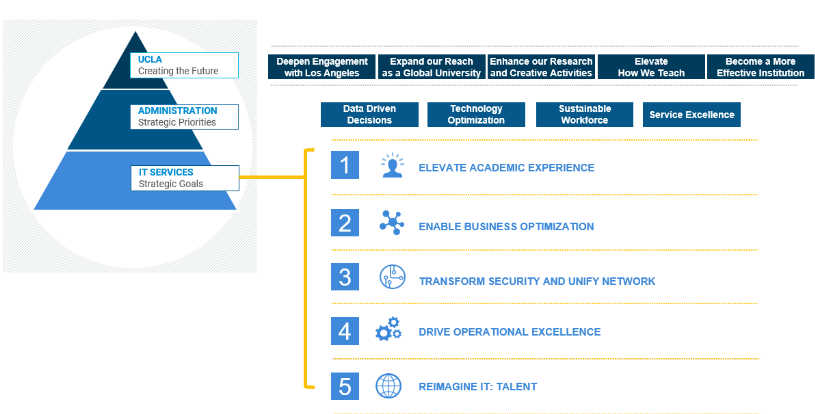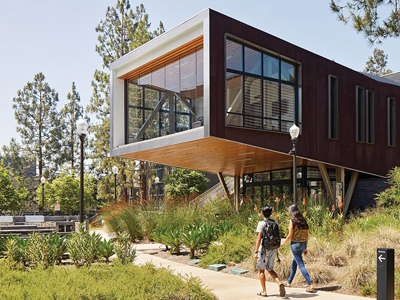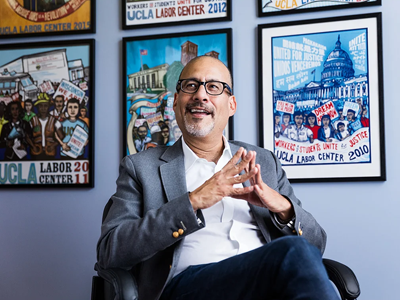Portfolio
The Digital Campus Roadmap will ensure the future IT operating model excels both in strengthening the foundation of technology at UCLA and advancing the mission of the university.

Strengthening the foundation of IT at UCLA will focus on campus infrastructure, information security, and application modernization. These initiatives will streamline IT systems and structures to simplify our digital landscape, enhance our core technical capabilities, and safeguard our IT environment. The Digital Campus Roadmap will allow UCLA to modernize its core technology services through key operational improvements and strategic enhancements (i.e., unification of our campus network, improvements in our procurement process enabled by Jaggaer, etc.). These efforts will also eliminate redundancy and unsupported software applications and deploy modern solutions to address unmet needs.
- Enterprise Infrastructure Solutions: Allows UCLA to modernize its technology services through key operational improvements and strategic enhancements.
- Enterprise Information Security: Addresses major technical and non-technical challenges that hinder UCLA's overall information security maturity.
- Application Modernization: Eliminates redundancy and unsupported applications and deploys modern applications to address unmet user needs.
Advancing the mission will focus on supporting flexible, holistic, and user-friendly experiences and designing an ecosystem of teaching and learning technologies in partnership with campus stakeholders (i.e., enhancements to classroom technology, modernization of data services to assist in data quality and availability, etc.). These efforts will be a catalyst for creativity by enabling better information management and analytic capabilities and improving the faculty, researcher, staff, and student experience.
- Customer Experience & Relationship Management: Leverages current capabilities and a common approach to expanding customer experience and relationship management across campus.
- Enterprise Data and Analytics: Develops defined data governance and modernized data capabilities that will enable advanced analytics through emerging technologies.
- Academic Technology: Transforms educational models through technology to foster innovation in learning, teaching, and discovery.
Strengthening the foundation of IT at UCLA will focus on campus infrastructure, information security, and application modernization. These initiatives will streamline IT systems and structures to simplify our digital landscape, enhance our core technical capabilities, and safeguard our IT environment. The Digital Campus Roadmap will allow UCLA to modernize its core technology services through key operational improvements and strategic enhancements (i.e., unification of our campus network, improvements in our procurement process enabled by Jaggaer, etc.). These efforts will also eliminate redundancy and unsupported software applications and deploy modern solutions to address unmet needs.
- Enterprise Infrastructure Solutions: Allows UCLA to modernize its technology services through key operational improvements and strategic enhancements.
- Enterprise Information Security: Addresses major technical and non-technical challenges that hinder UCLA's overall information security maturity.
- Application Modernization: Eliminates redundancy and unsupported applications and deploys modern applications to address unmet user needs.
Advancing the mission will focus on supporting flexible, holistic, and user-friendly experiences and designing an ecosystem of teaching and learning technologies in partnership with campus stakeholders (i.e., enhancements to classroom technology, modernization of data services to assist in data quality and availability, etc.). These efforts will be a catalyst for creativity by enabling better information management and analytic capabilities and improving the faculty, researcher, staff, and student experience.
- Customer Experience & Relationship Management: Leverages current capabilities and a common approach to expanding customer experience and relationship management across campus.
- Enterprise Data and Analytics: Develops defined data governance and modernized data capabilities that will enable advanced analytics through emerging technologies.
- Academic Technology: Transforms educational models through technology to foster innovation in learning, teaching, and discovery.
Strategic Goals
UCLA Digital and Technology Solutions' strategic goals are designed to support the university’s commitment to academic and operational excellence. By enhancing the digital landscape, we empower faculty, staff, and students with advanced tools and services that are key for today’s educational and administrative demands. Visit our By the Numbers reports to see how we are progressing with these goals. We diligently align our strategic goals with the administration strategic plan and priorities and UCLA's strategic plan.

- Elevate the UCLA student, faculty, and staff experience through flexible and user-friendly solutions.
- Empower our academic community with a dynamic ecosystem of technologies and digital spaces suited for the future of teaching and learning.
- Provide modern applications that meet the academic, research, and admin needs of the university.
- Enable strategic decision-making through fully integrated institutional data and analytics platforms.
- Address major technical /non-technical challenges that hinder UCLA's overall info security maturity.
- Unify systems and structures to simplify and secure the digital landscape.
- Champion continuous improvement, consistently refining both business processes and technology to elevate service delivery.
- Deliver exceptional customer service and act as a trusted strategic partner to the campus.
- Develop a best-in-class organization and a workforce ready to support UCLA's continued ascent.
- Cultivate an organizational culture that promotes Equity, Diversity, & Inclusion (EDI), sustainability and our DTS values—innovation, employee fulfillment, and teamwork.
Strategic Outcomes
For Students

- Provides an end-to-end student lifecycle engagement system that support the entire student journey.
- Leverages technologies that enable an equitable and positive student learning experience regardless of where and when learning occurs.
For Faculty

- Provides access to an evolving ecosystem of technologies that enable innovative teaching and learning.
- Develop a cohesive data management framework to support the organization, publication, and reuse of cutting-edge research conducted at the university.
For Staff

- Increases availability and visibility of integrated institutional data allowing for more strategic decision-making
- Simplifies institutional-wide processes through automation, workflow, and a shift in culture, delivering a great user experience and finding the right solutions that drive mission-focused outcomes.
- Ensures technical infrastructure that allows for expansive collaborative opportunities for all students, faculty, and staff.

